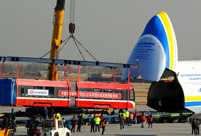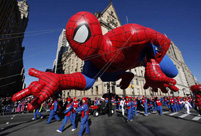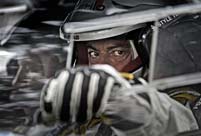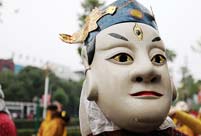(ANSA) - Catanzaro, December 6 - One of Italy's best-loved cultural icons, a pair of ancient Greek statues called the Riace Bronzes, is back home in a Calabrian museum after four years lying on their backs in the seat of the regional government.
"We are keeping a promise to give all the citizens of the world back one of its greatest treasures," said Culture Minister Massimo Bray.
He said the statues would be back on display in two weeks and that, given their "delicate" condition, the government would probably not try to have them moved to Milan in 2015 for the Expo world's fair in the northern Italian city that year.
Bray vowed to give the Bronzes "all the loving attention they need" to restore them to their full glory after the toll of undignified neglect in a store-room of the government offices in Reggio Calabria, on the other side of the southern Italian city.
"Thanks to Bray, the bronzes will soon be back gloriously on display," said Calabria Archaeological Superintendent Simonetta Bonomi.
She hailed the news that the public can start flocking back to admire two of the most stunning works ever recovered from the cultural hotbed created by the ancient Greek civilisation in southern Italy called Magna Graecia (Greater Greece).
A bigger, renovated showcase for the glorious warrior figures in Reggio Calabria's Museum of Magna Graecia is expected to be unveiled early next year.
Calabria's culture chief, Mario Caligiuri, said the opening of the revamped site "could represent our Expo," referring to the world's fair in Milan which is expected to give the Italian business capital a significant economic and cultural boost.
The statues were moved from the museum at the end of 2009 because the cultural institute badly needed restoration.
But the work at the museum became a victim of budget cuts and red tape, leaving the statues out in the cold and spurring a national and international outcry.
Leading Italian arts figures got a petition together and United Nations cultural organisation UNESCO branded the affair "a disgrace" in July.
This prompted a renewed pledge from local officials this summer.
"The situation is finally unblocked and will be remedied" said the managing director of Calabria's department of cultural heritage, Francesco Prosperetti.
"The Region of Calabria has given its fundamental contribution of five million euros, which will be used for building museum displays and completing installation work in the building, which should once more host the Riace Bronzes," Prosperetti said.
"If, as we hope, there aren't snags or legal hold-ups...
inauguration and opening to the public is conceivable...in the first months of next year", Prosperetti said.
Politicians had pressed Bray, since his appointment in April, to take fast action to protect the historically significant and priceless statues.
He responded by saying moves would be hastened to get them back in their rightful place "by the first quarter of 2014".
On Friday he said "it turned out that this forecast was actually pessimistic and I am proud to say that these two old friends of ours are now back where they belong even sooner than we hoped". Calabria takes the Bronzes so seriously that it has repeatedly refused permission for copies of the statues to be made and rejected pleas for Italian promotional events worldwide and for the 2001 G8 summit in Genoa.
In a citywide vote in 2003, the people of Reggio Calabria came out overwhelmingly against the "cloning" of the statues, which have been the Calabrian capital's biggest tourist draw since they were discovered.
The bronzes were discovered in 1972 by a Roman holiday-maker scuba diving off the Calabrian coast and turned out to be one of Italy's most important archaeological finds in the last 100 years.
Their' trip across town to the council site was supposed to be a brief one.
When they left the archaeological museum on December 22, 2009, superintendent Bonomi said it was "just for a six-month restoration".
The move was the first time in 28 years that the priceless 2,500-year-old bronzes had left the Museo Nazionale di Reggio Calabria.
The only previous occasion they were let out was in 1981, for a triumphant round-Italy tour, which sold out venues in Rome, Florence and Milan The statues are of two virile men, presumably warriors or gods, who possibly held lances and shields at one time. At around two metres, they are larger than life.
The 'older' man, known as Riace B, wears a helmet, while the 'younger' Riace A has nothing covering his rippling hair.
Both are naked.
Although the statues are cast in bronze, they feature silver lashes and teeth, copper red lips and nipples, and eyes made of ivory, limestone and a glass and amber paste.
Italy has the world's biggest trove of archeological treasures but the Riace Bronzes attracted particular attention.
This was partly due to their exceptionally realistic rendering and partly to the general rarity of ancient bronze statues, which tended to be melted down and recycled.
Stefano Mariottini, the scuba diver who first spotted one of the statues some 300 meters off the coast and eight metres underwater, said the bronze was so realistic that he initially thought he'd found the remains of a corpse.
A million people came to see them at various venues around Italy in 1981 and the pair were featured on a commemorative postage stamp that year.
The statues pulled in an average 130,000 visitors a year during their time at the Reggio Calabria museum.
 Heavy cargo flights taking off
Heavy cargo flights taking off In pictures: PLA's digital equipment
In pictures: PLA's digital equipment  Americans mark Thanksgiving Day with parades
Americans mark Thanksgiving Day with parades Love searching stories in cities
Love searching stories in cities  Shanghai shrouded in heavy fog
Shanghai shrouded in heavy fog Office ladies receive ‘devil’ training in mud
Office ladies receive ‘devil’ training in mud China's first nude photographer
China's first nude photographer Selected sports photos of the week
Selected sports photos of the week Treasure of Chinese culture- Nuo Dance
Treasure of Chinese culture- Nuo Dance  Youths in Night club: photo story
Youths in Night club: photo story Models dazzle at Int'l Yacht Model Pageant
Models dazzle at Int'l Yacht Model Pageant  Crystal scenery in China: Jilin fog glaze
Crystal scenery in China: Jilin fog glaze  Tianjin holds first pole dance championship
Tianjin holds first pole dance championship  Annual Santa Claus parade held in Canada's Montreal
Annual Santa Claus parade held in Canada's Montreal China's aircraft carrier passes through Taiwan Strait
China's aircraft carrier passes through Taiwan StraitDay|Week|Month